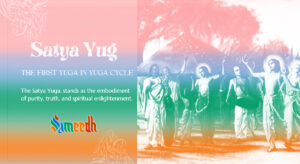Satya Yug, also known as the Golden Age or the Age of Truth, is the first of the four Yugs (ages) in Hindu cosmology. According to Hindu belief, the world goes through a cycle of four Yugs, each characterized by a decline in moral and spiritual values. Satya Yug is considered the most virtuous and spiritually advanced of these ages.

The God of Satya Yug is the Supreme Being, Vishwarupa Narayana (Lord Vishnu) Who is the Whole Unified Universe . He is there in all Yugas . But Treta, Dvapar and Kali Yug people worship the Avataras : Ram, Krushna, Buddha respectively.
In every yuga cycle, or chaturyug, there are ten prominent avatars known as the Dashavatar. Of these, four appear in Satya Yug: Matsya, Kurma, Varaha, and Narasimha. Additionally, there are also several other prominent avatars in Satya Yug, such as Dhanvantari, Mohini Murti.
Key Characteristics of Satya Yuga:
- Duration: Satya Yuga is the longest of the four yugas, lasting for 1.728 million years.
- Virtue and Righteousness: It is described as an age of truth, virtue, and righteousness. People in Satya Yuga are inherently good, honest, and devoted to spiritual practices.
- Absence of Vice: There is a minimal presence of evil and vice in Satya Yuga. People live in harmony with each other and with nature.
- Spiritual Wisdom: The pursuit of spiritual knowledge and wisdom is a central focus of life in Satya Yuga. People are deeply connected to their inner selves and the divine.
- No Need for Formal Religion: As people are inherently virtuous, there is no need for formal religious rituals or elaborate ceremonies in Satya Yug.
- Longevity: Human life spans are significantly longer in Satya Yug compared to the subsequent yugas.
Popular Story: The Samudra Manthan, or the churning of the ocean, is a significant event in Hindu mythology, and it is believed to have occurred during the Satya Yug. The Samudra Manthan is a story found in various Hindu scriptures, including the Purans and the Mahabharat.
Key elements of the Samudra Manthan include the use of Mount Mandara as the churning rod and Vasuki, the serpent, as the churning rope. The Devas (celestial beings) and Asuras (demons) collaborated in churning the ocean to obtain the nectar of immortality (amrita) and other treasures.
During the churning, various divine entities and objects emerged from the ocean, including the poison Halahala. Lord Shiv came to the rescue by consuming the poison to protect the world, earning him the name “Neelakanth” (the one with a blue throat).
The churning also yielded the emergence of several valuable items, including the goddess Lakshmi (symbolizing wealth and prosperity), the divine physician Dhanvantari carrying the pot of amrita, the celestial elephant Airavata, and the wish-fulfilling tree Kalpavriksha.
The Samudra Manthan is a rich allegorical tale that conveys spiritual and moral lessons, highlighting the cosmic struggle between the forces of good and evil and the pursuit of immortality and divine knowledge.
Significance: The significance of Satya Yug lies in its portrayal of an idealized age where righteousness and truth prevail. It serves as a benchmark for understanding the decline in moral and spiritual values as the world progresses through the subsequent yugas (Treta Yug, Dvapara Yug, and Kali Yug). Satya Yug represents a state of spiritual and moral perfection that humans should aspire to achieve, even as they navigate the challenges presented in the later ages.
While the concept of yugs is a part of Hindu cosmology, it’s important to note that these time periods are symbolic and not necessarily measured in the same way as historical or geological eras. They are meant to convey cyclical patterns of cosmic and spiritual evolution in Hindu philosophy.